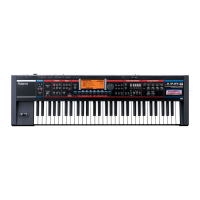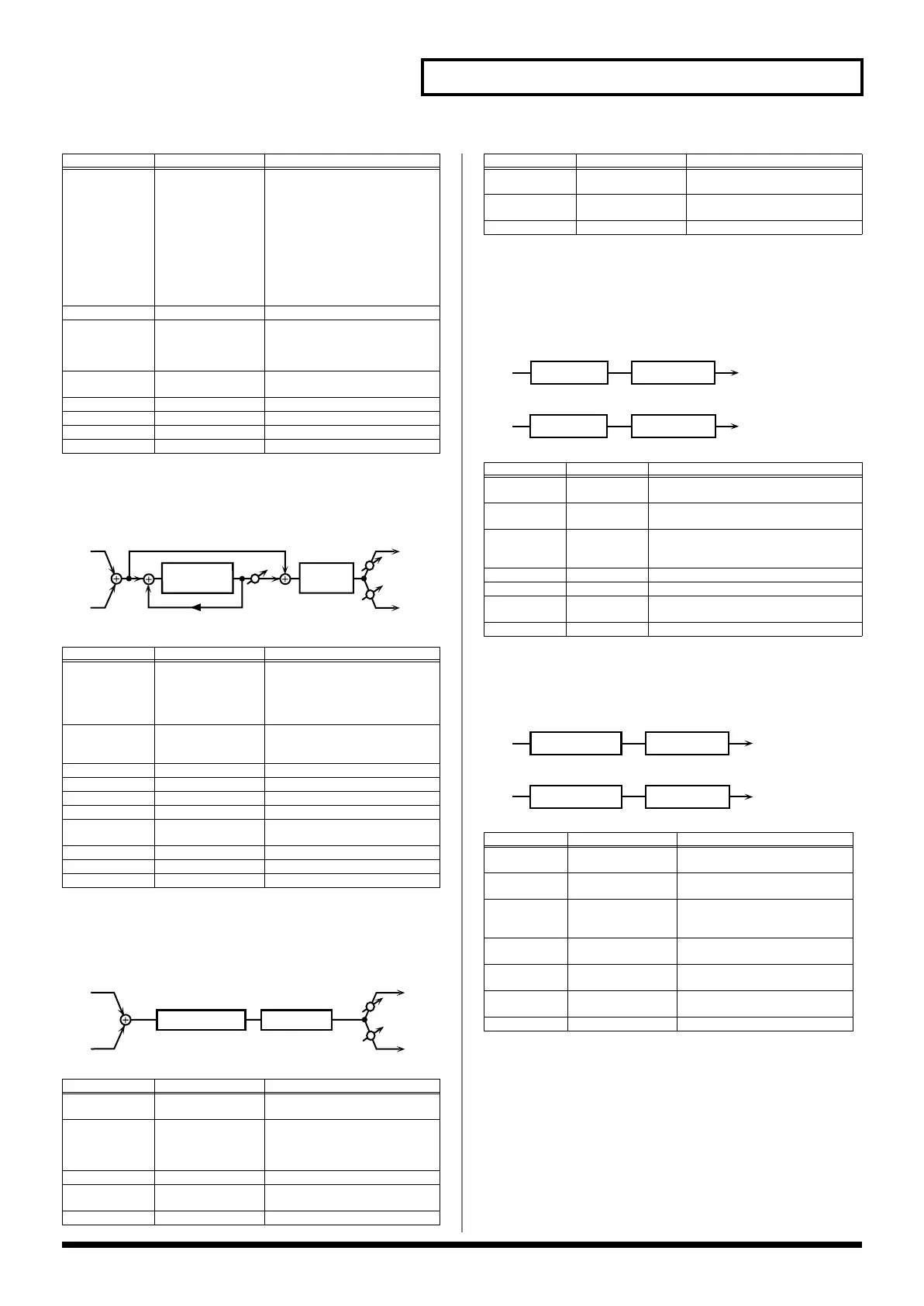135
Adding Effects
13: MULTI STAGE PHASER
Extremely high settings of the phase difference produce a deep
phaser effect.
fig.MFX-13
14: INFINITE PHASER
A phaser that continues raising/lowering the frequency at which the
sound is modulated.
fig.MFX-14
15: RING MODULATOR
This is an effect that applies amplitude modulation (AM) to the input
signal, producing bell-like sounds. You can also change the
modulation frequency in response to changes in the volume of the
sound sent into the effect.
fig.MFX-15
16: STEP RING MODULATOR
This is a ring modulator that uses a 16-step sequence to vary the
frequency at which modulation is applied.
fig.MFX-16
Polarity
INVERSE,
SYNCHRO
Selects whether the left and right
phase of the modulation will be
the same or the opposite.
INVERSE:
The left and right
phase will be opposite. When
using a mono source, this
spreads the sound.
SYNCHRO:
The left and right
phase will be the same. Select
this when inputting a stereo
source.
Resonance # 0–127 Amount of feedback
Cross
Feedback
-98– +98 % Adjusts the proportion of the
phaser sound that is fed back
into the effect. Negative (-) set-
tings will invert the phase.
Step Rate # 0.10–20.00 Hz, note Rate of the step-wise change in
the phaser effect
Mix # 0–127 Level of the phase-shifted sound
Low Gain -15– +15 dB Gain of the low range
High Gain -15– +15 dB Gain of the high range
Level 0–127 Output Level
Parameter
Value Explanation
Mode
4-STAGE, 8-
STAGE,
12-STAGE, 16-
STAGE, 20-
STAGE, 24-STAGE
Number of phaser stages
Manual # 0–127 Adjusts the basic frequency from
which the sound will be modu-
lated.
Rate # 0.05–10.00 Hz, note Frequency of modulation
Depth 0–127 Depth of modulation
Resonance # 0–127 Amount of feedback
Mix # 0–127 Level of the phase-shifted sound
Pan # L64–63R Stereo location of the output
sound
Low Gain -15– +15 dB Gain of the low range
High Gain -15– +15 dB Gain of the high range
Level 0–127 Output Level
Parameter
Value Explanation
Mode
1, 2, 3, 4 Higher values will produce a
deeper phaser effect.
Speed # -100– +100 Speed at which to raise or lower
the frequency at which the sound
is modulated
(+: upward / -: downward)
Resonance # 0–127 Amount of feedback
Mix # 0–127 Volume of the phase-shifted
sound
Pan # L64–63R Panning of the output sound
Parameter Value Explanation
Resonance
Mix
L in
R in
L out
R out
Pan R
Pan L
2-Band
EQ
Multi Stage
Phaser
Infinite Phaser 2-Band EQ
L in
R in
L out
R out
Pan R
Pan L
Low Gain
-15– +15 dB Amount of boost/cut for the
low-frequency range
High Gain -15– +15 dB Amount of boost/cut for the
high-frequency range
Level 0–127 Output volume
Parameter
Value Explanation
Frequency #
0–127 Adjusts the frequency at which modula-
tion is applied.
Sens # 0–127 Adjusts the amount of frequency modu-
lation applied.
Polarity UP, DOWN Determines whether the frequency mod-
ulation moves towards higher frequen-
cies (
UP
) or lower frequencies (
DOWN
).
Low Gain -15– +15 dB Gain of the low frequency range
High Gain -15– +15 dB Gain of the high frequency range
Balance # D100:0W–
D0:100W
Volume balance between the direct
sound (D) and the effect sound (W)
Level 0–127 Output level
Parameter
Value Explanation
Step 01–16
0–127 Frequency of ring modulation at
each step
Rate # 0.05–10.00 Hz, note Rate at which the 16-step se-
quence will cycle
Attack # 0–127 Speed at which the modulation
frequency changes between
steps
Low Gain -15– +15 dB Amount of boost/cut for the
low-frequency range
High Gain -15– +15 dB Amount of boost/cut for the
high-frequency range
Balance # D100:0W–
D0:100W
Volume balance of the original
sound (D) and effect sound (W)
Level 0–127 Output volume
Parameter Value Explanation
L in
R in
L out
R out
Ring Mod
2-Band EQ
2-Band EQ
Ring Mod
L in
R in
L out
R out
Step Ring Mod
2-Band EQ
2-Band EQ
Step Ring Mod
JUNO-G_e.book 135 ページ 2006年2月13日 月曜日 午後2時44分

